The Rally: Live reaction from the WTA tennis' return, in Palermo
Aug 03, 2020Dominant Coco Gauff double bagels Arantxa Rus in Madrid opener
By David Kane Apr 25, 2024Katie Volynets wins longest WTA singles match of the year in Charleston
By Associated Press Apr 02, 2024Victoria Azarenka lines up Elena Rybakina early in Dubai, where all Top 4 women are entered
By Associated Press Feb 19, 2024Novak Djokovic, Iga Swiatek headline revamped 2024 United Cup team event
By Associated Press Oct 20, 2023Ranking Reaction: Iga Swiatek kicks off milestone 70th consecutive week at No. 1
By John Berkok Jul 31, 2023Arantxa Rus defeats German teenager Noma Noha Akugue in Hamburg final for first WTA title
By Associated Press Jul 29, 2023Noma Noha Akugue, 19, reaches Hamburg final in WTA main-draw debut
By TENNIS.com Jul 28, 2023Doubles Take: Rotterdam, Doha and more
By Van Sias Mar 09, 2021Melbourne: Venus Williams opens 2021 in style at Yarra Valley Classic
By Matt Fitzgerald Jan 31, 2021The Rally: Live reaction from the WTA tennis' return, in Palermo
After five months away, and three months of exhibitions, the tours have returned for real.
Published Aug 03, 2020
Advertising
On the first day of tour-level tennis since March, Steve Tignor and Joel Drucker will be rallying back and forth as the WTA returns in Palermo. Stay tuned to this page throughout the day for additional updates. (Last update: 5:30 p.m. ET)
Hi Joel,
“This is not a false alarm!” Russ Thaler announced at the start of Tennis Channel’s broadcast from Palermo this morning. After five months away, and three months of exhibitions, the tennis tours have returned for real.
If you’re like me, Joel, you’re kind of holding your breath right now, hoping that the WTA gets through this week and makes a statement that the sport can come back safely, even without a bubble. Those of us in the United States have seen what has happened with the return of baseball over the last month; it only took one weekend for the coronavirus to send an entire team, the Miami Marlins, into quarantine. If tennis can’t be played safely in Palermo, in a country where the virus is relatively controlled, it will lead to more questions about whether it should come to the U.S. later this month.
OK, we know about the risks. What about the tennis itself? I’m pleased at what I’m seeing to start this morning. Donna Vekic has always been a favorite of mine. I like her strong serve, I like how solidly she hits her forehand, even if the technique is a little funky, and I like that you can glimpse her inner struggle to believe in herself when she’s on court. As players, we know everyone goes through this struggle, but Vekic’s pensive face makes it obvious. Sometimes she finds the belief, sometimes she hangs her head and doesn’t. But seeing that quiet battle makes me root for her.
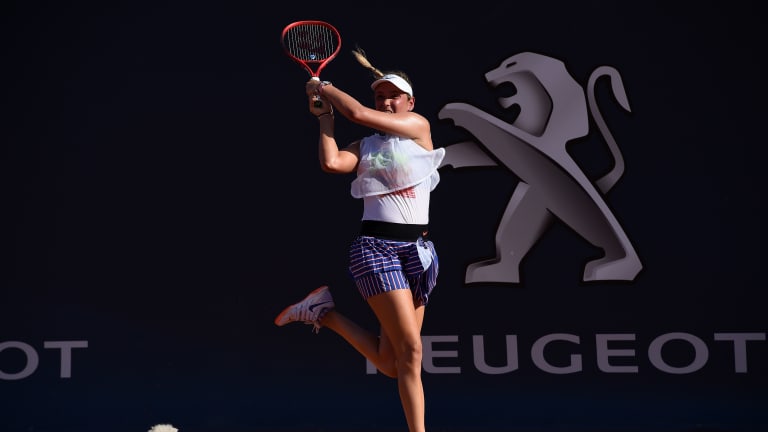
The Rally: Live reaction from the WTA tennis' return, in Palermo
© Getty Images
Advertising
Donna Vekic. (Getty Images)
So far, after 20 minutes of watching, I’ll note two things. (1) It’s windy in Palermo. (2) Knowing this match is real, and that it matters in the long run of the season, makes me more patient in my viewing. When I watch an exo, I look for the spectacular shot; when I watch a tour match, which I haven’t done in five months, I watch to see how it slowly unfolds.
How do you feel seeing real tennis again, Joel?
Steve,
It’s great to be watching WTA action. Here I am, sitting in my living room, nearly 6,500 miles from Palermo, and the dynamic of it all is quite different than the exhibition-style tennis we’ve recently watched. The exhibitions were indeed a great showcase of skills, of shot-making and athleticism, like a set of elegant beads on the table. But now, in competition, the beads are once again becoming threaded. The longstanding narratives of each player spring to life.
Like you, Steve, I’ve long enjoyed the crisp quality of the 24th-ranked Vekic’s game. And certainly, even on this windy day on the red clay, she’s showing it off nicely.
As for Arantxa Rus, Vekic's opponent, I recall seeing her upset Kim Clijsters at Roland Garros in 2011. This naturally compelled me to inspect her subsequent Grand Slam results—and learn that only once has she made it to the fourth round of a major (Roland Garros, 2012). Seeing her labor early versus Vekic, I’m reminded of something Martina Navratilova once told me: When you’re rusty from not having competed, your head literally hurts from not having engaged yourself this way for a while.
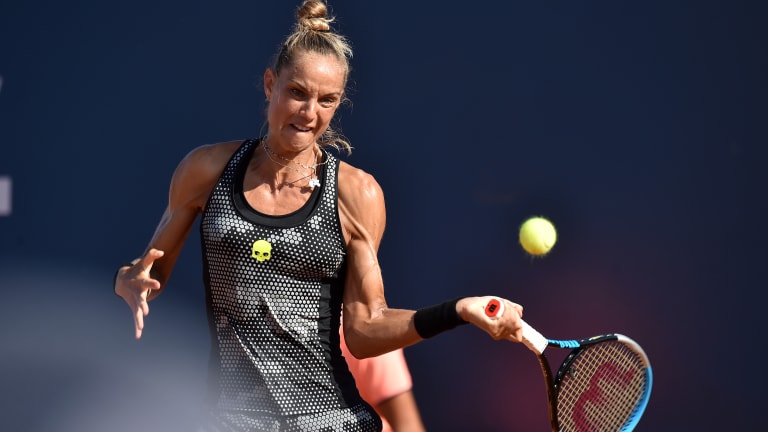
The Rally: Live reaction from the WTA tennis' return, in Palermo
© Getty Images
Advertising
Arantxa Rus. (Getty Images)
But the big point in all of this is that the tennis plot line has resumed—past, present, and hopefully on into the future.
Steve, how do you think the rust factor will continue to play out in Palermo?
Joel,
There are going to be unprecedented amounts of rust for the players to shake off this week. I don’t think any of them, other than after injury layoffs, have ever been away from real competition for more than three months. Now they’re jumping back onto a clay court, on a hot and gusty day, for the first time in five months. After her win over Rus this morning, Vekic said her goal for the week was to get in as many matches as she can. Palermo is, hopefully, just a beginning for everyone.
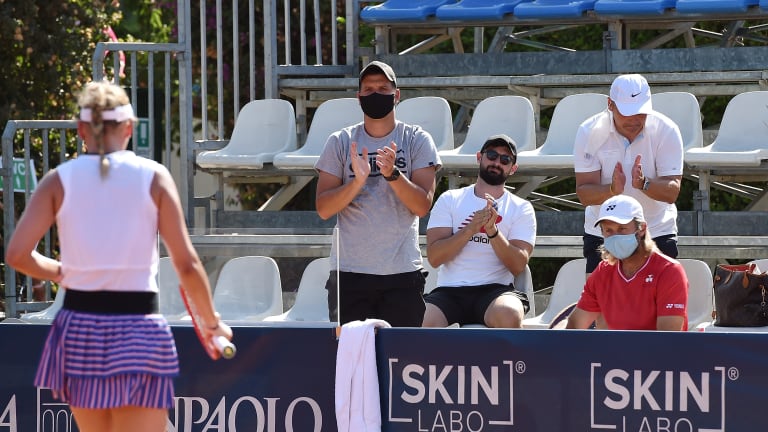
The Rally: Live reaction from the WTA tennis' return, in Palermo
© Getty Images
Advertising
Vekic, the first winner of the WTA restart, and various spectators. (Getty Images)
So far we’ve seen our first victor, Vekic, and now we’ve seen our first 13-minute game, between Sara Errani and Sorana Cirstea. It came as something of a surprise to me to see that Errani, a 33-year-old Italian who entered as a wild card, is still on tour. She’s ranked No. 169 now, a far cry from 2012, when she reached the final at Roland Garros and won the title in Palermo. Errani doesn’t seem to grunt quite as loudly as she once did, and she doesn’t cover quite as much ground, but she can still grind an opponent down. I’ve always enjoyed watching Errani more in doubles, where she can show off her considerable and under-appreciated all-court skill, and let herself emote more than she does in singles.
That 13-minute first game reminded me of something I’d forgotten this summer, Joel: What deuce does for tennis. We haven’t seen much of deuce lately. Two events, the Ultimate Tennis Showdown and World TeamTennis, did away with it entirely. But deuce is what gives traditional tennis its character. Long, back-and-forth games are what build tension and turn matches into battles. They bring out the grit in players and test their patience in a way that no-ad doesn’t. It’s good to have deuce back.
And as much I’ve enjoyed the exos we’ve seen, it’s good to have an old-fashioned tournament back, too. I like having a day of potentially long matches ahead. When you’re watching from home, as we all are these days, you can tune in and out of the event as the day goes along, and not feel like you’ve missed any of the essential drama. There’s a time to speed things up, and a time to slow things down.
Steve,
It’s been a few years since I saw Errani, but instantly, I recalled what made watching her enjoyable. In the spirit of Arantxa Sanchez Vicario, David Ferrer and Lleyton Hewitt, she is a first-rate fighter—engaged, focused, willing to do whatever it takes to grub out these points. Seeing her today, it’s no wonder Errani’s 178 clay-court match wins are more than any other active player. As one of my favorite Billie Jean King quotes goes, “Persistence is a talent.”
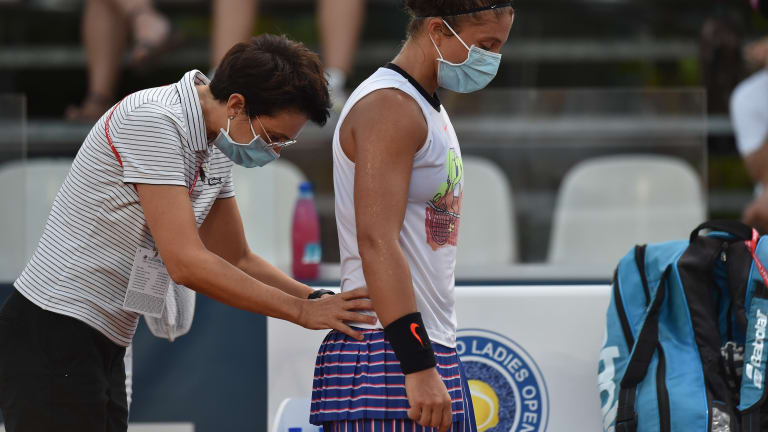
The Rally: Live reaction from the WTA tennis' return, in Palermo
© Getty Images
Advertising
Sara Errani masks up as she consulted the tournament doctor. (Getty Images)
As events like Palermo unfold and pro tennis recommences after such a long layoff, I wonder which specific talents will initially be more important than others. Do the playing styles that require a wide range of shots and tactics—ala Roger Federer, Nick Kygrios, Ash Barty, Sofia Kenin—take longer to attain proficiency than such baseliners as Novak Djokovic and Simona Halep? Certainly in Palermo, amid wind and clay, it’s probably best to hunker down like Errani and build your points from the ground up.
One thing I’m also fascinated by: How have various players kept themselves sharp during these months away? Surely, there's been ample time for fitness: flexibility, agility, strength. But when it comes to tennis, what’s been the mix of drills, practice sets and even, quite possibly, technical enhancements?
These questions remind me of the topics that often engage me in the early rounds of a tournament: broad speculation about the ways players seek to improve. As mentioned, the bead has been threaded, the pro tennis plot line gingerly resumed. One match at a time, we’re all crossing our fingers and hoping it can continue.
Steve, what kind of topics run through your mind as a pro tournament gets underway?
Joel,
Three sets, lots of deuce games, lots of long rallies, lots of drop shots, lots of lobs, lots of topspin and slice, a few moonballs, more than a few service breaks and momentum shifts, and a visit from the trainer or two: Errani vs. Cirstea not only brought tennis back, it brought clay-court tennis back, and all that comes with it. Frankly, I’m exhausted and I never left my couch.
Was this a be-careful-what-you-wish-for situation? I wrote earlier that I was happy to see deuce games again after so many events without them, but did I really want a three-hour first-round match to blow the schedule apart on the first day? If you’re a network TV producer, Errani-Cirstea, which started in broad daylight and ended under electric light, is what makes faster formats like WTT and UTS seem appealing.
But if you had the time, this was a worthy battle, one that awarded your attention span and kept you guessing until the final marathon deuce game was over. One minute it looked sure to go Errani’s way; a minute later Cirstea had the upper hand. It also showcased what you noted as the best aspect of Errani’s game: Her constant presence. Through three sets, she was always there, never taking a shot or a point off, and she earned her win. She also earned it with a flourish, hitting a series of forehand winners to break serve and close it out at 5-4 in the third.
MATCH POINT:
The Rally: Live reaction from the WTA tennis' return, in Palermo
Advertising
What did you think of the match, Joel? Were you ready for a marathon on day one? And are you, like me, looking forward to seeing what Daria Kasatkina can do next, in her 2020 reset?
Steve,
Ah, here we are, having just witnessed a Monday marathon. Having covered many tournaments, we’re each well aware just how unpredictable those opening days can be. That’s part of the fun. After all, sports is one of the few realms where surprise does not pose danger.
Sometimes those first-round matches fly by. But when an epic happens on day one, the sensation is visceral, akin to watching a football game and seeing the first long play that becomes a touchdown. The entire tournament has now come to life. I’ll also admit I’m pleased to see Errani demonstrate our earlier comments about her persistence.
Wed to this opening day crackle is the notion of possibility: If Errani can so vividly showcase her superpower, why not the same for the other contenders?

The Rally: Live reaction from the WTA tennis' return, in Palermo
© Getty Images
Advertising
Daria Kasatkina has fallen in the rankings, but the former Top 10 talent remains one of the tour's most intriguing players. (Getty Images)
In the case of Kasatkina, this was a player who as recently as October 2018 was ranked No. 10. By the end of 2019, she’d plummeted to No. 69, often looking disaffected and even feeble. This was disturbing, as from my vantage point, Kasatkina plays an incredibly versatile, tactically nimble game, on a potential par with such astute greats as Martina Hingis. But throughout 2019, the magic—and even worse, the eagerness—seemed to have vanished from Kasatkina’s fingers. At the Australian Open, for example, she went out meekly in the first round to Madison Keys, 6-3, 6-1. Just prior to the pandemic, Kasatkina reached the semis in Lyon, but lost in three sets to No. 136 Anna-Lena Friedsam.
Time in tennis moves so quickly. In less than two years, Kasatkina’s arc has migrated from potential star to enigma. And though I hinted earlier that these multi-faceted players often take a while to display their range of assets, perhaps all this time off has given Kasatkina even more of a chance to refresh herself.
Steve, what’s your take on how tennis might look for Kasatkina at this stage? And how do those opening days of a tournament play out for you?
Joel,
Come for Kasatkina, stay for Paolini.
That would be 24-year-old, 95th-ranked Jasmine Paolini of Italy, who was granted a wild card into Palermo and who did some good things with it today against Daria Kasatkina. Paolini, whose father is Italian and mother is partly of Ghanaian descent, is just 5’3”, but she plays with an infectious, forward-moving energy, and is a clean ball-striker to boot. Unlike a lot of Italians, who typically learn the game on clay, Paolini looks to be proactive and attack the ball. I liked seeing her follow her approaches forward and finish with nice touch volleys at net.
Of course, as Andy Roddick used to say, at some point your opponent is probably going to show you why he’s ranked where he’s ranked. And at least in the first set, Paolini showed us why she’s still No. 95 at the relatively advanced age of 24. She broke Kasatkina for 5-5, and then was immediately broken back, and for every impressive winner she created and rally she constructed, she gave another back. To win at the highest levels when you’re 5’3” takes some special talent, or, in the case of the last top player who was that height, Dominika Cibulkova, some special energy.
The same goes Kasatkina. As you said, Joel, she has Martina Hingis-like racquet skills, but this is not the era of Martina Hingis. Looking down the WTA rankings, there’s no one in the Top 15 who plays with the pure finesse of a Kasatkina, who is 5’7” and likes to rally and counter-punch from well behind the baseline. There are plenty of players with variety—Barty and Andreescu come to mind—and at least one, Halep, who is qualifies as undersized. But they can all find ways to be offensive and take points into their own hands. Today, Kasatkina was on the defensive even against Paolini.
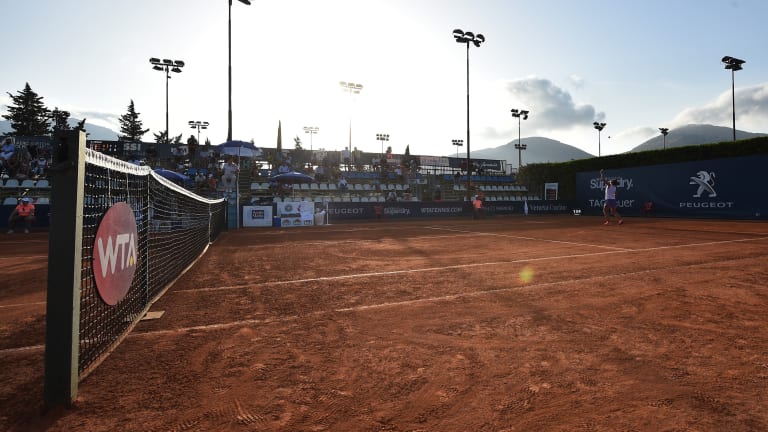
The Rally: Live reaction from the WTA tennis' return, in Palermo
© Getty Images
Advertising
Kasatkina’s second serve is her first problem; it’s a bloop. And her backhand, which was once a beautifully versatile swoop, seems to have become abbreviated, as if nerves keep her from fully swinging through it. I always liked Kasatkina’s honesty and self-deprecation. (I also like that she’s a Rafael Nadal fanatic, which is a refreshing change from the near-universal adoration of Roger Federer among the players.) But as appealing as brutal honesty is in a personality, it can work against you as a player. It seems Kasatkina could only keep her self-doubt at bay for so long, and once she started to lose a few matches in a row last year, all of her psychological defenses collapsed.
Still, she’s just 23, so we can still hope for more from the Russian. She’s someone I’ll keep rooting for in 2020. I’d like to say the same for Jasmine Paolini. Will we see this Italian shotmaker again after this week? If not, her energy was fun while it lasted. It’s seeing different talents like her that make opening days at tournaments worth coming back for.
Steve,
Oh, the perils of returning to competition. Surely, just like any recreational player coming back after a long layoff, Daria Kasatkina and Jasmine Paolini had each hoped that, win or lose, her first match back to WTA competition would be reasonably routine. Play a couple of brisk sets, taking less than two hours. For the winner, on to the next match; for the loser, on to more practice. Chalk it all up to the process.
Not quite. Over the course of three hours and nine minutes, these two engaged in rough-and-tumble clay-court tennis. This was trench warfare, paused by each player taking medical timeouts and wearing thigh wraps, punctuated by rust-inspired errors and bursts of impressive firepower.
In the end, the match ending 21 minutes past midnight, wild card Paolini was the winner, 5-7, 6-4, 6-4. Despite all of Kasatkina’s prior experience, she failed to hold serve once in the last two sets, an indicator of the pervasive passivity that triggered her defeat. Hand it to Paolini for asserting herself at key points with a number of big returns and groundstrokes.
Many tales will be told about how players have grappled with what has likely been the longest break from competition since any of them first picked up a racquet. As Paolini versus Kasatkina showed, when it comes to owning the sharpness that comes from match play, there are no short cuts—only battles. Fitting indeed that the WTA’s return would come on that toughest of surfaces, European clay.
In theory, this arduous effort wasn’t merely a shaking off of the cobwebs. This was a complete sweeping. But in practice, who can say just how well Paolini will recover and be able to play her next match? This is the picture of pandemic-era tennis, where players must manage the uncertainty of fitness, recovery, technical sharpness, tactical awareness, emotional management. More than ever, competition is all one big mystery now. Which makes it highly intriguing.
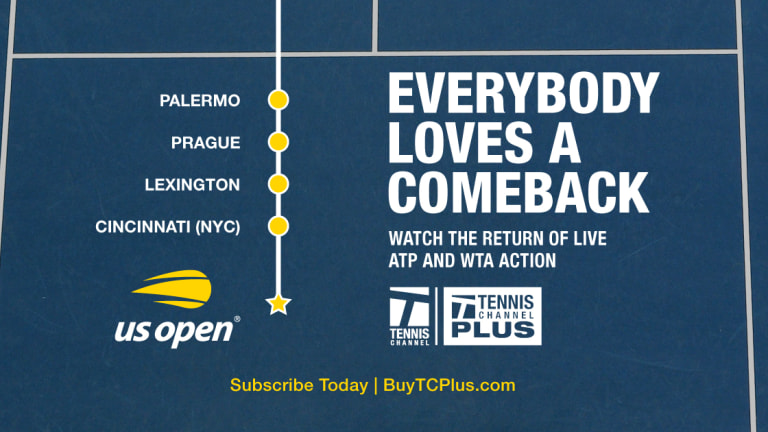
The Rally: Live reaction from the WTA tennis' return, in Palermo